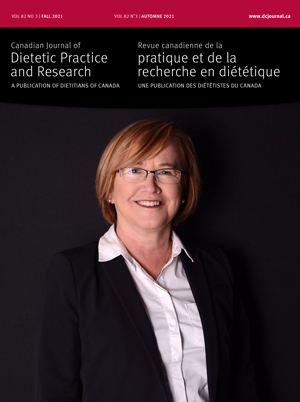Abstract
Purpose: Postsecondary students who move to a new country to continue their education experience a drastic shift in food landscape, often resulting in unhealthy dietary adaptations.
Methods: This mixed-method study explored the eating experiences and dietary patterns of 30 international students attending a Canadian university. Data were collected through focus groups that were analyzed thematically and dietary records analyzed for compliance with Canada’s Food Guide for Healthy Living (2007).
Results: Results showed that many participants want to maintain home country food traditions, yet their new independent living status and novel food environments led to changes in dietary habits. Limited food skills, busy schedules, reduced access to familiar foods, and fast-food environments contributed to unhealthy eating patterns. These perceptions were reflected in the high consumption of “other”, less nutritious foods and low servings of fruits and vegetables, milk products and alternatives, and grain products.
Conclusions: These findings show that international university students face dual challenges of transitioning into independent living without sufficient food skills and family supports, and exposure to unfamiliar and unhealthy food environments. Resources need to be developed for newly enrolled international students that emphasize food awareness, food skills, and healthy eating habits.
Résumé
Objectif. Les étudiants de niveau postsecondaire qui déménagent dans un autre pays pour poursuivre leurs études constatent un changement radical du paysage alimentaire, ce qui se traduit souvent par des adaptations alimentaires malsaines.
Méthodes. Cette étude à méthodes mixtes s’est penchée sur les expériences et les habitudes alimentaires de 30 étudiants étrangers fréquentant une université canadienne. Les données ont été recueillies dans le cadre de groupes de discussion et ont été analysées par thème, et les journaux alimentaires ont été analysés afin de les comparer aux recommandations du Guide alimentaire canadien (2007).
Résultats. Les résultats ont montré que de nombreux participants souhaitent conserver les traditions alimentaires de leur pays d’origine, mais que leur nouveau statut de vie autonome et leur nouvel environnement alimentaire ont entraîné des changements dans leurs habitudes alimentaires. Des compétences alimentaires limitées, des horaires chargés, un accès réduit aux aliments habituels et des environnements alimentaires favorisant la consommation de repas-minute contribuaient à l’adoption d’habitudes alimentaires malsaines. Ces perceptions se traduisaient par une grande consommation d’aliments « autres » moins nutritifs et de peu de portions de fruits et légumes, de produits laitiers et substituts, et de produits céréaliers.
Conclusions. Ces résultats montrent que les étudiants universitaires étrangers font face à un double défi : la transition vers une vie autonome sans compétences alimentaires suffisantes et sans soutien familial, et l’exposition à des environnements alimentaires malsains et peu familiers. Des ressources doivent être élaborées pour les étudiants étrangers nouvellement inscrits qui mettent l’accent sur la conscience alimentaire, les compétences alimentaires et de saines habitudes alimentaires.



